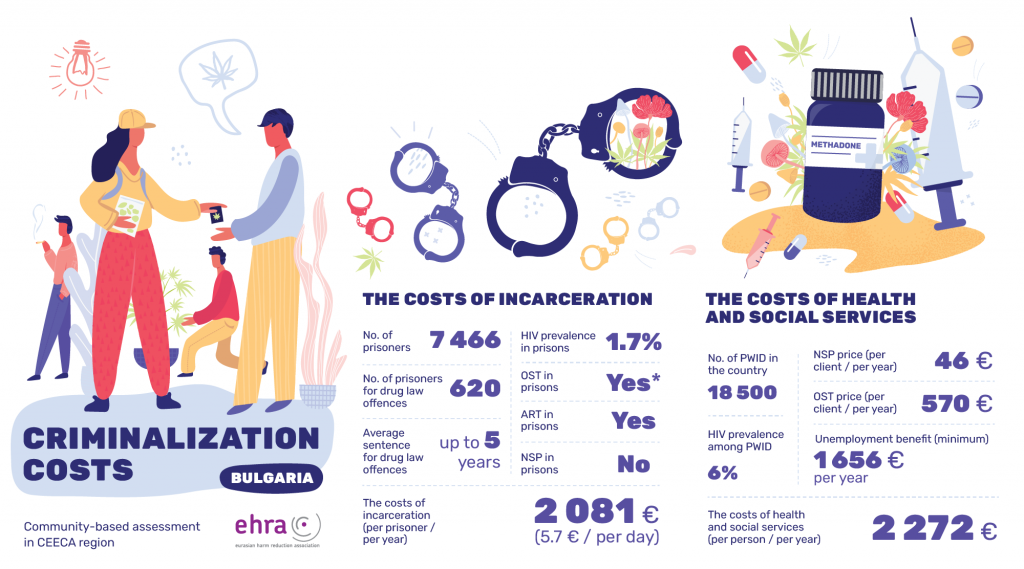In 2019, there were 7,466 people in prison in Bulgaria, of which 620 (8%) were incarcerated for drug law offences [1] which can result in a term of imprisonment of up to five (5) years [2]. HIV prevalence in prisons was estimated at 1.7% in 2016 with antiretroviral therapy (ART) reportedly being available [3]. Opioid substitution therapy (OST) is available but only within one prison in Bulgaria and only for people who are already receiving methadone prior to their entry into the prison, with such inmates having to pay to continue with the programme [4]. No needle/syringe programmes (NSP) are being implemented in the prisons of Bulgaria [5].
The cost of incarcerating each person in prison is €2,081 per year, or €5.70 per day [6].
There were estimated in 2020 to be 18,500 people who inject drugs in Bulgaria [7] with a HIV prevalence in 2019 estimated at 6% [8]. As of January 2021, the cost of NSP was around €46 per person, per year. The cost of OST depends on the type of programme; low-threshold programmes – that have a waiting list – cost €570 per person, per year, and the most popular private practice programmes cost around €1,000 per person, per year [9]. Unemployment benefit in 2019 was €1,656 per person, per year, or €4.54 per day or €138 per month; this equates to 60% of the average daily wage or average daily social security income upon which social security contributions have been paid, or are payable, to the Unemployment Fund for the previous 24 calendar months (2 years) [10].
Consequently, the total cost of support a person who injects drug in community settings is €2,272 per month.
[1] Aebi MF, Tiago MM. SPACE I – 2019 – Council of Europe Annual Penal Statistics: Prison populations. Strasbourg; Council of Europe, 2020. https://wp.unil.ch/space/files/2021/02/200405_FinalReport_SPACE_I_2019.pdf (accessed 4 August 2021).
[2] European Monitoring Centre for Drugs and Drug Addiction (EMCDDA). Bulgaria Country Drug Report 2019. Luxembourg; Publications Office of the European Union, 2019. https://www.emcdda.europa.eu/system/files/publications/11344/bulgaria-cdr-2019_0.pdf (accessed 5 August 2021).
[3] Joint United Nations Programme on HIV and AIDS (UNAIDS). The Key Populations Atlas. Geneva; UNAIDS. https://kpatlas.unaids.org/dashboard (accessed 3 August 2021).
[4] Harm Reduction International (HRI). Global State of Harm Reduction 2020, Regional Overview 2.2 Eurasia. London; HRI, 2021. https://www.hri.global/files/2020/10/26/Global_State_HRI_2020_2_2_Eurasia_FA_WEB.pdf (accessed 3 August 2021); and additional information from national partners.
[5] HRI, Ibid.
[6] Aebi M F, Tiago MM. SPACE I – 2020 – Council of Europe Annual Penal Statistics: Prison populations. Strasbourg; Council of Europe, 2021. https://wp.unil.ch/space/files/2021/04/210330_FinalReport_SPACE_I_2020.pdf (accessed 3 August 2021).
[7] Hines LA, Trickey A, Leung J, Larney S, Peacock A, Degenhardt L, et al. Associations between national development indicators and the age profile of people who inject drugs: results from a global systematic review and meta-analysis. Lancet Glob Health 2020;8(1):e76–91. DOI: https://doi.org/10.1016/S2214-109X(19)30462-0 (accessed 5 August 2021).
[8] EMCDDA, Ibid.
[9] Information submitted by national partners.
[10] National Social Security Institute. Unemployment Benefits 2019. Sofia; National Social Security Institute, 2021. https://www.nssi.bg/en/faqs/faqs-2 (accessed 5 August 2021).

